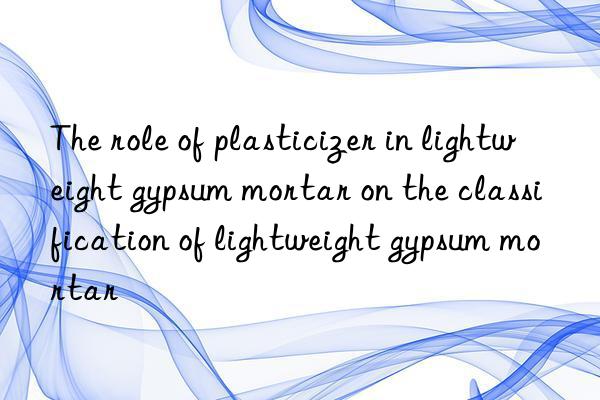
1. Plasticizers
Lightweight gypsum mortar plasticizers have been used in China since the 1960s. However, due to the limitations of construction specifications, the use of lightweight gypsum mortar plasticizers has been limited. The research was not in-depth and systematic, and no consensus was reached on some issues. Moreover, because my country did not yet have unified quality standards and application technical regulations for lightweight gypsum mortar plasticizers, the use of this product in engineering projects gradually decreased. With the development of material technology, the performance of lightweight gypsum mortar plasticizers has been greatly improved. Incorporating lightweight gypsum mortar plasticizers into lightweight gypsum mortar for masonry is the development direction.
The addition of lightweight gypsum mortar plasticizer into lightweight gypsum mortar for masonry can improve the workability of lightweight gypsum mortar and replace the cement lime mixed with lime paste in lightweight gypsum mortar, which is beneficial to economical use. Lime plaster has a certain significance and can solve the environmental pollution caused by lime. Adding lightweight gypsum mortar plasticizer into cement lightweight gypsum mortar can save cement. At the same time, using lightweight gypsum mortar plasticizer can improve the quality of lightweight gypsum mortar. The excellent water retention, fluidity and cohesiveness can overcome the shortcomings of cement mixed with light gypsum mortar such as explosive ash, large shrinkage and low strength. This ensures the quality of the masonry. Therefore, the use of lightweight gypsum mortar plasticizer has significant social and economic benefits. Any substance added to a polymer system that can increase the plasticity of the polymer system can be called a plasticizer. The main function of plasticizer is to weaken the secondary bonds between polymer molecules, that is, van der Waals forces, thereby increasing the mobility of the polymer molecular chain and reducing the crystallinity of the polymer molecular chain, that is, increasing the plasticity of the polymer. , manifested in the decrease in hardness, modulus, softening temperature and embrittlement temperature of the polymer, while the elongation, flexibility and polymer increase.
Classification of plasticizers
Plasticizers can be divided into two major types according to their mode of action, namely internal plasticizers and external plasticizers. Internal plasticizers are actually part of the polymer. Generally internal plasticizers are secondary monomers introduced during the polymerization process of the polymer. Since the second monomer copolymer is in the molecular structure of the polymer, the regularity of the polymer molecular chain is reduced, that is, the crystallinity of the polymer molecular chain is reduced. For example, vinyl chloride-vinyl acetate is softer than vinyl chloride homopolymer. The use temperature range of internal plasticizers is relatively narrow, and they must be added during the polymerization process, so less internal plasticizers are used.
External plasticizer is a low molecular weight compound or polymer, which can be added to the polymer that needs to be plasticized to increase the plasticity of the polymer. External plasticizers are generally a high boiling point, relatively difficult to volatilize liquid or a low melting point solid, and most of them are ester organic compounds. Usually they do not react chemically with polymers, and their interaction with polymers is mainly swelling at elevated temperatures, forming a solid solution with the polymers. External plasticizers have comprehensive properties, are easy to produce and use, and are widely used. Nowadays, plasticizers generally referred to as plasticizers refer to external plasticizers.
</p

 微信扫一扫打赏
微信扫一扫打赏

